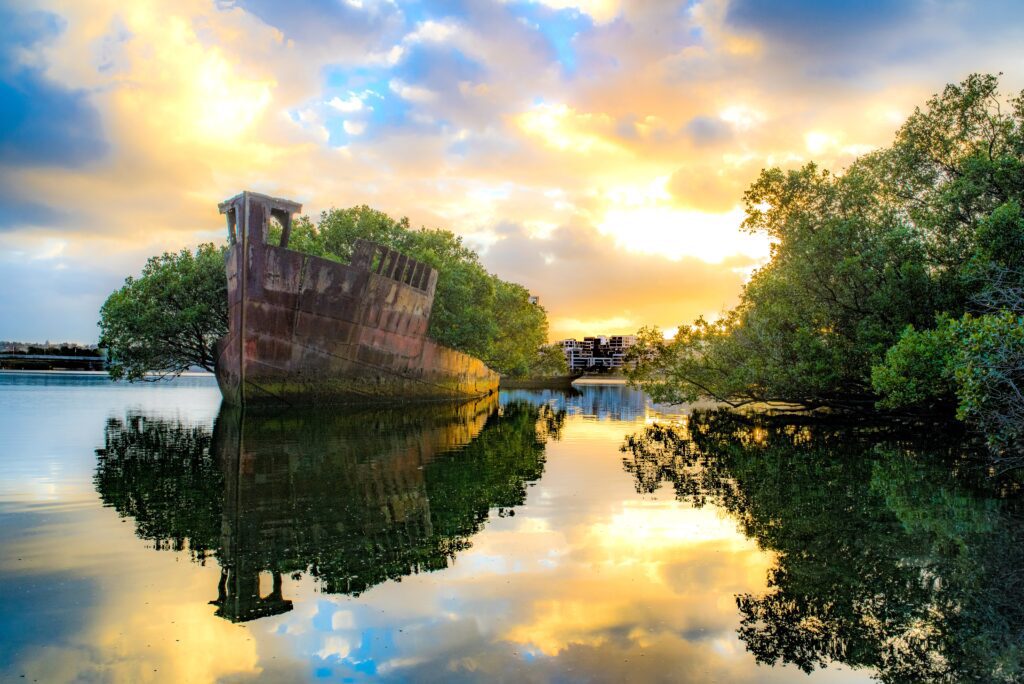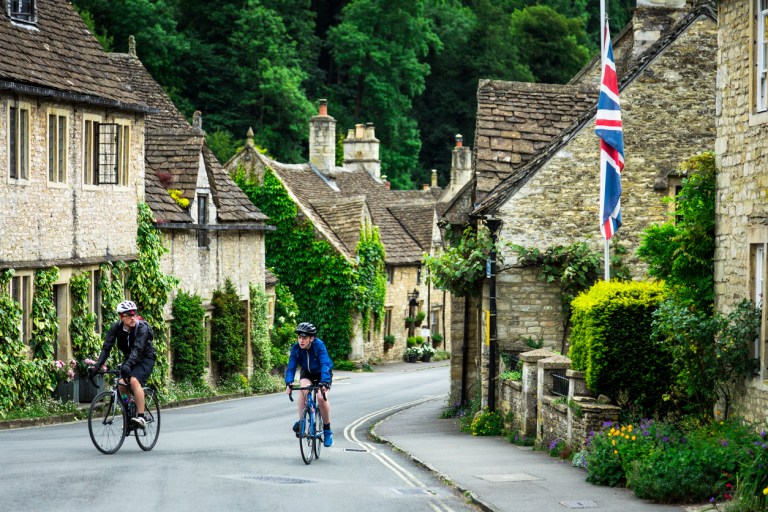It’s been said that everything old becomes new again. This feels especially true when it comes to formerly abandoned places that allowed nature to take over.
To celebrate the power of greenery to transform a space, we’ve rounded up a list of various locations around the world that fell into disrepair but became nature preserves, public parks, and wildlife refuges through mindful intervention and respect for natural processes. In some cases, the redeveloped sites are more similar to what they once were decades (or even centuries) ago.
From garbage dumps to golf courses and even a ship, read on to see inspiring examples of what can happen when ecosystems have space and time to flourish and when humans work with the environment to preserve the past.
Spreepark Berlin | Berlin, Germany

In southeastern Berlin, there’s an old Ferris wheel, carousel, and rusty remnants of children’s rides from the past. This area is known as Spreepark, an amusement park that opened in 1969 and went on to develop a complicated backstory leading to its shutdown in 2001. But a bright future is on the horizon for the dilapidated area: In 2016, Berlin initiated a plan to redevelop the park.
After thousands of citizens shared suggestions, the site is in the process of becoming a public and accessible park that “turns art into an experience in the middle of urban nature.” The vision is to repurpose existing infrastructure and revive rides so visitors and Berliners can experience something unique, enjoyable, and sustainable. Learn more about the sustainability efforts here.
The area around the Ferris wheel is scheduled to open in 2024/2025 and the full site is expected to be complete by 2026.
Rancho Vistoso Preserve | Tucson, Arizona

In February 2022, the town of Oro Valley, Arizona, announced the purchase of Vistoso Golf Course, a 202-acre property that had shut down in 2018.
The town worked with The Conservation Fund to raise $1.8 million to acquire the property, which will become a nature preserve and trail system — and create something that honors the natural environment rather than eliminates it.
Home to mountain scenery, local wildlife, Sonoran Desert vegetation, Native American petroglyphs, and paved trails, the area is a “tremendous opportunity for natural open space, extensive walking and biking trails, passive recreation, and a permanent wildlife corridor that will benefit our community for generations to come,” Oro Valley Mayor Joe Winfield said in a press release.
SS Ayrfield | Sydney, Australia

A former cargo freighter in Sydney, Australia, is now known as a “floating forest.” The century-old ship, built in 1911, can be seen in the city’s Parramatta River with greenery pouring over the sides and a thriving thicke of mangrove trees on board.
Before the ship became a photogenic forest, it was used to transport supplies to U.S. soldiers during World War II, The Sydney Morning Herald reported. After 60 years of service, the ship was brought to Homebush Bay to be dismantled and potentially repurposed. However, this never happened due to the marine wrecking yards in the area going out of business — allowing something surprising and delightful to occur instead.
Over time, mangroves started growing from inside the vessel, creating a luscious green scene against a backdrop of the rusted metal. Today, the site is a tourist attraction (to be admired from afar) and a unique relic, likely to stay put for many years.
Pistol Creek | Berlin, Connecticut
Pistol Creek, a multi-mile loop in Connecticut, was also once a golf course before it became a public trail. Back in 2005, the golf course shut down and was purchased a few years later by the town, halting plans to turn the area into a space for condominiums and housing development, the Hartford Courant reported. Instead, the area became a nature preserve.
Today, the park remains a popular space for birding, biking, dog-walking, and simply enjoying the view, which includes hills and paved paths that were former cart paths. While it’s been decades since the golf course was running, if you look closely, some say you can still decipher former holes and be reminded of its transformation.
Tommy Thompson Park | Toronto, Canada

Leslie Street Spit — now named Tommy Thompson Park — is a former garbage dump-turned-wildlife refuge nestled in the heart of Canada’s biggest metropolitan area.
According to the CBC, the 3-mile-long peninsula was established as a breakwater to protect the city’s expanding port and shoreline. So in 1959, development involved dumping construction waste into the lake to form the perimeter while filling the inner areas with sand dredged from the Don River, per the Toronto Star.

Fast-forward to the 1970s, and a site for port-related facilities was no longer needed. But over the years, the area became home to a diverse community of flora and fauna and a thriving scene for birdwatching. “The natural processes that had evolved during the planning and construction of the site had shaped the spit into a truly ‘accidental wilderness,’” the Tommy Thompson Park website explains.
Read more about Tommy Thompson Park (and see photos) here.
The Kuttamperoor River | Kerala, India
In Kerala, India, a previously neglected river that was once biologically “dead” has since been revived, thanks to the combined efforts of the state government, a village council, and the river’s surrounding communities.
The Kuttamperoor River is a 7.4-mile tributary of the Pampa and Achencoil rivers, which had long been a life-sustaining source for drinking water, irrigation of paddy fields, work for hundreds of fishermen, and transport of goods, The Hindu reported. However, years of pollution, encroachments, and neglect took their toll — and by 2005, the river had “died a slow death.” Its flow width had vastly dwindled from around 330 feet to under just 50 feet in some areas.
Thankfully, two decades later, the Kuttamperoor has now expanded to almost 165 feet — about the width of a football field. Per The Hindu, the remarkable transformation started in 2011. Over the following years, local villagers and the Kerala government united to propel the renovation efforts.
“I never thought Kuttamperoor [would] come to life again,” a man named Rajeevan, who grew up near the river, said in 2017, per The Hindustan Times.
The Tegel Projekt | Berlin, Germany


After the final plane took off in 2020 at the Tegel international airport in Berlin, Germany, the 1,235-acre site sat unoccupied. Now, the dormant airport is getting an über-modern makeover.
Enter: the Tegel Projekt (also referred to as Berlin TXL), an eco-friendly initiative commissioned by the state of Berlin. The project aims to turn the space into a green metropolis, a hub for innovative research, and even a college campus. More than 2,500 students are expected to live in the former airport terminal building as they study at the Berlin University of Applied Sciences (Berliner Hochschule für Technik University).
View this post on Instagram
Construction is set to be complete in the 2030s, and it could serve as an inspiring example for the many abandoned airports worldwide.
Krejci Dump | Boston Heights, Ohio


In 1985, the National Park Service acquired the Krejci Dump in Boston Heights, Ohio: a toxic wasteland filled with rusty metal and contaminated with chemicals. Today, after a decades-long effort, it is part of Ohio’s Cuyahoga Valley National Park and home to flourishing wildflowers, salamanders, toads, bald eagles, and more.
The cleanup was the largest in NPS history, according to Chris Davis, a plant ecologist for the park. But it was well worth the effort. “Krejci was a ‘biological desert,’ meaning almost nothing could live in the area,” he told National Geographic. He added: “To find this diversity of species there today is remarkable.”
Although it wasn’t an easy road, the transformation is a reminder that hope is not lost when it comes to rehabilitating polluted lands.
RELATED: Ancient Archaeological Site in Rome, Home to World-Famous Stray Cat Colony, Opens to Tourists












